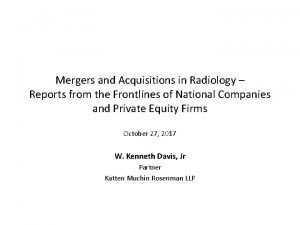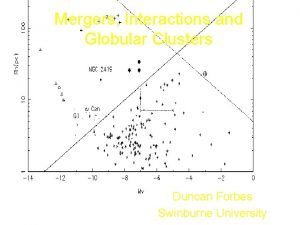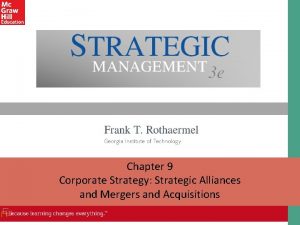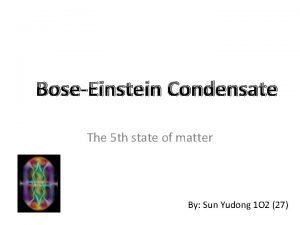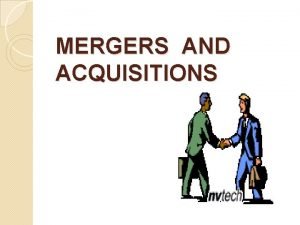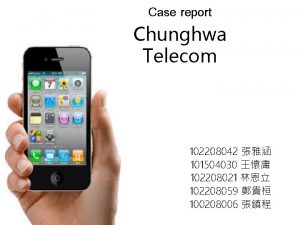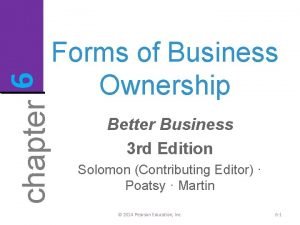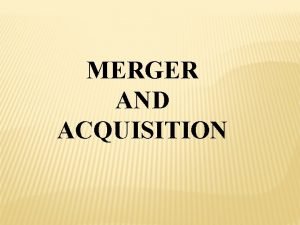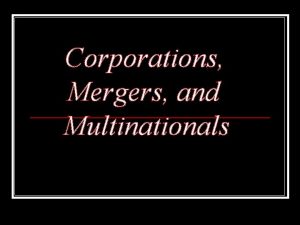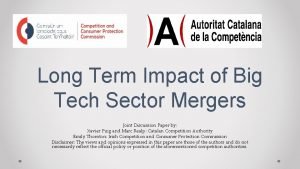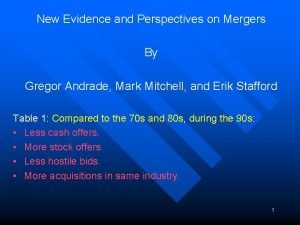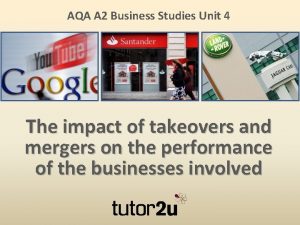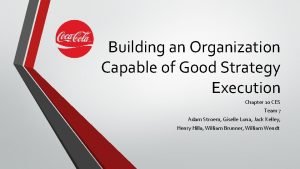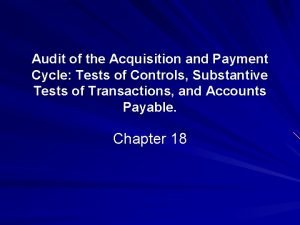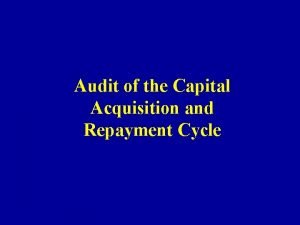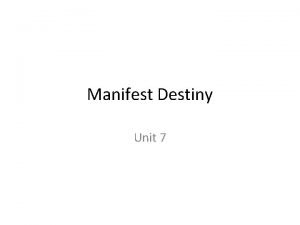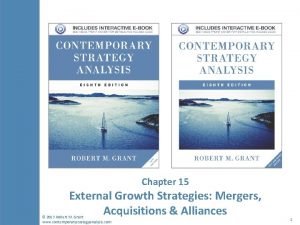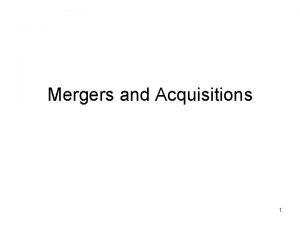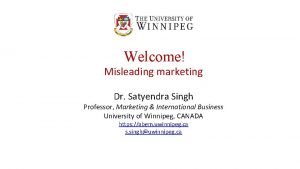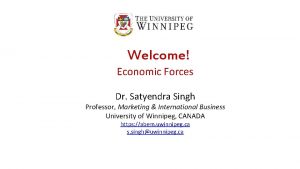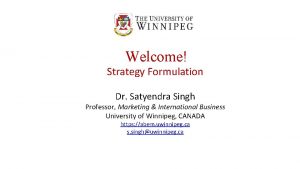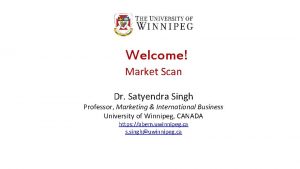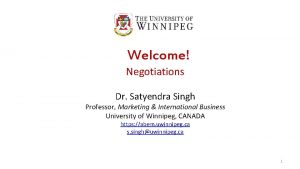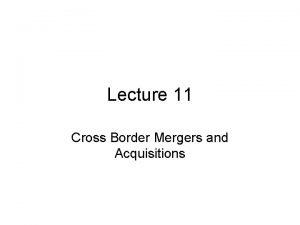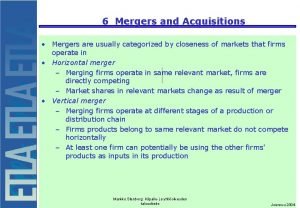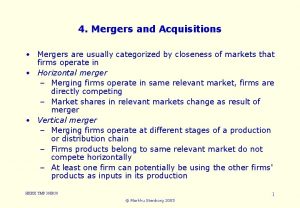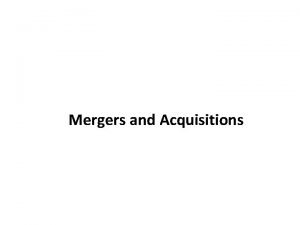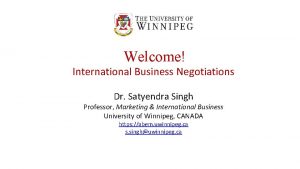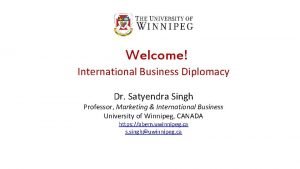Welcome Mergers Acquisitions Dr Satyendra Singh Professor Marketing






























- Slides: 30

Welcome! Mergers & Acquisitions Dr. Satyendra Singh Professor, Marketing & International Business University of Winnipeg, CANADA https: //abem. uwinnipeg. ca s. singh@uwinnipeg. ca

2

Before you acquire a firm: Analyze Products of the Firm Bottom up (daily use products), Top down (like a firm, sector…) Financial Health of the Firm Earning, Balance sheet, Loss and Profit account… Management of the Firm Reputation, can they take it to the next level Geographical Exposure Local vs. international Stock Market Valuation of the Firm P/E over time, EPS over time 3

Logic of the M&A Strategy Value creation through synergy Economies of Scale Economies of Scope Transferring competencies Sharing infrastructure Access to patents, Growth potential, Risk sharing ↑ Debt capacity, ↓ cash flow variability Combined cash flow > Individual If market value < true value Needs restructuring; inefficient management Where is the value coming from? 4

Value: Can we turn the inefficiency into efficiency? 5

Value creation: Financial perspective Price per share (market, not book) Growth, risk, market speculation (based on P/E)… Earning per share TTM (Trailing 12 months), Sales side vs buy side P/E Ratio If too ↓, suspicious. If too ↑, why? Why buy a company with high P/E must have reason Capital structure impacts P/E ratio leveraged Everything being identical in the same industry, P/E should be about same Check P/E from industry sector, FTSE 100 Obtain justifiable values based on the ratios. 6

Value creation: Example 1 Pre-merger Post-merger Price/share = $75 EPS = $5 Price/share = $80 EPS = $7 P/E = 15 P/E = 11. 4 P/E dropped following merger, so the value of the merger is coming from the current projects rather than its future growth potential 7

Value creation: Example 2 P/E 2016 2017 2018 2019 2020 2021 2022 $100/$1 100/2 100/3 100/4 100/5 100/6 100/7 100 50 33. 3 25 20 16. 7 14. 2? ! P/E = Price to earning per share ratio P/E = 100 is too high needs justification P/E match industry level everything being equal Expect growth 100% increase in EPS must continue If P/E drastically different merger arbitrage Value from future growth potential on sustainable basis For industry (P/E): http: //pages. stern. nyu. edu/~adamodar/New_Home_Page/datafile/pedata. html 8

Why do M&As Fail? Premium Paid (shares) > synergy/value Expensive: bankers, accountant and lawyers Competitive bidders appear As such cash acquisition is riskier Acquirer takes all the risks Stock Acquisition – risk is shared Arbitrageurs can buy outstanding stocks and force price concession Lengthening the acquisition process makes it more expensive 9

Can we create synergy/close the gap? Firm P Earning # shares EPS P/E A $60 $50 m 10 m $5 12 ie $1 x 15 m =$15 m B $20 $10 m $1 20 Combined $60 m 15 (10+5) $60 m/#15 m = $4/share Loss of $1 per share ($5 -$4) (+$10 x 10 m = $100 m premium) Can we close the gap? ) A agrees to buy B’s share for $30 (ie pay premium of $10/share) ie Half share of A for every share of B (. 5 A = B) ie B’s 10 m share equivalent to A’s 5 m shares, total being 15 m shares 10

Managerial motives to M&A Conflict of interest Managers like running large firms due to additional pay and prestige Overconfidence Hubris Hypothesis (HH) pursue merger even if low value because they believe their ability to manage is great enough to succeed. Unethical behavior Managers destroy shareholders’ value for personal gain, though they believe that they’re doing the right thing for shareholders. 11

Period: Major M&A activities 12

Buys for $2 b 13

Types of takeover… Takeover Transfer of ownership from 1 firm to another Merger Combination of 2 firms into 1 legal entity Similar-sized firms are combined So are their names One may be of the parents’ or a combination Daimer. Chrysler SIRIUS XM Both shareholders approve the transaction 14

Types of takeover Acquisitions Purchase of 1 firm by another Larger firm buys smaller firmer, which becomes a subsidiary Kraft foods buys Cadbury Amalgamation Merger that requires fair opinion by an independent expert on the value of the firm’s shares when public minority exists Consolidation An entirely new form is created 15

Types of M&A activities Related Vertical Supplier or customers Horizontal Competitors Product extension Complementary products Market extension Complimentary markets Unrelated Conglomerate Everything else 16

Friendly takeover Target firm is willing to be taken over Investment bank prepares tender offer for the management Can be initiated by acquirer Both parties structure the deal to their mutual satisfaction, eg Capital gain Acquirer uses target as asset for tax deductions Graceful exit environmental, lawsuits… Agree on initial purchase price; pay later 17

Friendly acquisition process 18

Hostile takeover Transactions bypass the management Management is opposed to the deal Acquirer already accumulated 20% of Target’s stock So, tender offer is made directly to shareholders 19

Hostile takeover: Defense tactics Shareholders rights plan Poison Pills Dilute the share by offering more shares and by giving discount (50%) to Target’s shareholders, making it expensive/difficult for Acquirer Selling key assets Sell the assets that Acquiring firm is interested Pay large dividends to remove excess cash from Target’s balance sheet White knight Seek out friendly acquirer 20

Critical shareholder % 10% Early warning Acquirer is accumulating a position– toehold 20% Takeover bid – Not allowed further, must tender bid, open to all 50. 1% Control (Simple majority) Can replace board and control management 66. 7% amalgamation Shareholders approve amalgamation proposal 90% Minority squeeze out Minority shareholders are forced to tender their shares to avoid frustration 21

Regulatory approval All mergers must be approved by regulators In the USA, all mergers over $60 m must be approved by the government before the proposed takeover occurs EU Commission has similar process Emerging markets More strict due to colonization 22

Governments can interfere to control competition or for security reasons 23

Merger arbitrage Once a tender offer is announced, the uncertainty about whether the takeover will succeed adds volatility to the stock price This uncertainty creates an opportunity for investors to speculate on the outcome of the deal It creates volatility Market share price > offer price (may be more bid) Market share price = offer price (deal is likely) Little trade in shares (deal may not go through) Significant trade in shares (deal is likely) 24

Case study: Merger arbitrage Firm A Price per share = $30 # shares = 10 m Market Capital = $300 m Firm B (Target) Price per share = $50 # Share = 1 m Market Capital = $50 m A is acquiring B for $60 m in A’s Share (A needs 2 m more shares @ $30/share $60 m) ie 2 shares of A for every share of B (2 A = B) Suppose due to volatility, share for B is trading at $55 So buy 1 share of B $55 (exchange it for $60) Short sell 2 share of A $60 Net gain $5 25

Other factors can also cause share price fluctuations, eg 26

Leverage: Impact of capital structure on P/E, assets Firm A Invested $100 K Not borrowed, so no liability # shares = 10, 000 COGS (50%) = -$50 K Depreciation = -$20 K Operating Income (Pre-tax) = $30 K Tax (30%) = -$9 K Interest = 0 Earning after tax = $21 K EPS = $2. 10 Analyst P/E should be 10 So, market share price = $21 Market capitalization = $210 K But A put $100 K Equity + Liability = $210 K + $0 Total Assets (ie mkt value of equity) = $210 K By borrowing you’ll ↑ assets Firm B Invested only $10 K Borrowed $100 K @ 5% (ie $5 K) # shares = 10, 000 COGS (50%) = -$50 K Depreciation = -$20 K Operation Income (Pre-tax) = $30 K Non-operating Income = $2 K Interest paid = -$5 K Total Operating Income = $27 K Tax (30%) = -$8. 1 K Earning after tax = $18. 9 K EPS = $1. 89 Analyst P/E should be 10 So, market share price = $18. 90 Market capitalization = $189 K But B put only $10 K Equity + Liability = $189 K + $100 K Total Assets = $289 K Ie. $279 K assets + $10 K cash = $289 K 27

Impact of M&A on goodwill Goodwill = Price paid – MV of Target firm Equity = $1, 250 – (MV of target assets – MV of target Liabilities) = $1, 250 – ($2, 200 - $1, 050) = $100 28

Questions? s. singh@uwinnipeg. ca https: //abem. uwinnipeg. ca

 Radiology mergers and acquisitions
Radiology mergers and acquisitions Hr issues in mergers and acquisitions
Hr issues in mergers and acquisitions Franchise mergers & acquisitions advisors
Franchise mergers & acquisitions advisors Corporate restructuring merger and acquisition
Corporate restructuring merger and acquisition Mergers and acquisitions in strategic management
Mergers and acquisitions in strategic management Mergers and acquisitions rumors
Mergers and acquisitions rumors Duncan forbes hr
Duncan forbes hr Horizontal strategic alliance
Horizontal strategic alliance What is mergers and acquisitions
What is mergers and acquisitions Bose einstein condensate
Bose einstein condensate Dr satyendra yadav
Dr satyendra yadav Sarwan singh kundan singh
Sarwan singh kundan singh Promotion from associate professor to professor
Promotion from associate professor to professor Concentric merger
Concentric merger Telecom mergers
Telecom mergers Disadvantages of a merger
Disadvantages of a merger Basic rules of photography
Basic rules of photography Backflip acquisition
Backflip acquisition Corporations mergers and multinationals
Corporations mergers and multinationals Tech sector mergers
Tech sector mergers Gregor andrade
Gregor andrade Mergers and takeovers tutor2u
Mergers and takeovers tutor2u When are capabilities-motivated acquisitions essential?
When are capabilities-motivated acquisitions essential? Mexican cession map
Mexican cession map Cycle based testing audit
Cycle based testing audit Capital acquisition and repayment cycle definition
Capital acquisition and repayment cycle definition United states acquisitions and annexations 1857-1904
United states acquisitions and annexations 1857-1904 Us territorial acquisitions map
Us territorial acquisitions map Alliances and acquisitions
Alliances and acquisitions Wise men three clever are we
Wise men three clever are we Sandeep singh jolly
Sandeep singh jolly
